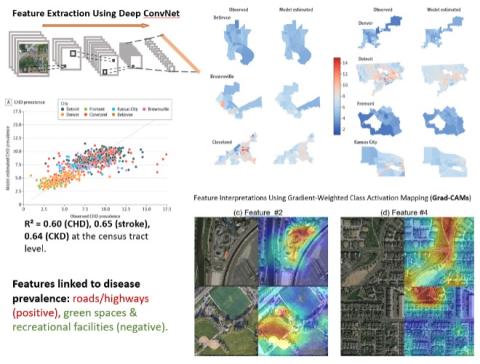Research Focus Areas
Our research integrates geospatial concepts, advanced data processing, harmonization, analysis, and machine learning, centering on several key themes:
- AI-Enhanced Environmental Risk Assessment: Utilizing deep learning and computer vision techniques on satellite and street view imagery to extract granular features of the built environment (e.g., road quality, green space, building conditions) and quantify their association with cardiovascular disease risk and health disparities across diverse geographic settings.
- Geographic and Environmental Determinants of Health: Investigating how dynamic environmental exposures (like air pollution, neighborhood walkability), mobility patterns, and healthcare accessibility interact to shape cardiovascular health outcomes and contribute to health inequities. This includes analyzing factors like proximity to clinical trial sites and the environmental footprint of healthcare delivery.
- Foundation Models and AI for Integrated Spatial Health Intelligence: We are actively exploring and adapting cutting-edge Artificial Intelligence, including Large Language Models (LLMs) and multimodal Foundation Models, to create a deeper, more integrated understanding of spatial health dynamics.
Research Objectives
The core objectives of the SHEIL Program are to:
- Develop and validate innovative AI and machine learning models using diverse geospatial data sources (satellite, street view, sensor data) to precisely assess environmental exposures relevant to health.
- Quantify the impact of built, natural, and social environments on cardiovascular health, cardiometabolic conditions, and health disparities using advanced spatial and statistical methods.
- Identify specific geographic areas and populations at heightened risk due to socio-environmental factors to guide targeted interventions.
- Analyze how dynamic factors like environmental change, mobility, and access to resources influence population health trajectories.
- Generate actionable, evidence-based insights to inform public health strategies, clinical decision-making, urban planning policies, and resource allocation for risk mitigation and health promotion.


